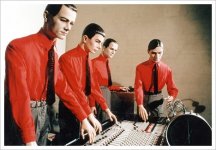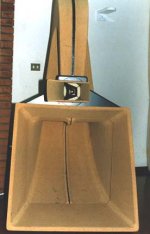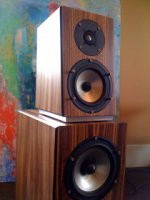Yes, it was: "Zauberlehrling".Wasn't that from Goethe?
And that German story led to Fantasia and Fantasound and there was stereo's first popularity and here we go again to Germany & to Joachim striving for perfecting it and the social fantasy loop goes on and on...Kling Klang, Kling Klang, DIY Kraftwerk. But we must admit, German engineers were always strong in sonics. KlangFilm, awesome pioneers.
Attachments
Thanks Salas. I feel honored in that company. My company with Allen Perkins is even called "Sonics" but it is now american owned. And i had to go to Japan to my first listen to a Klangfilm system at one of the Beta Testers of SACD. In fact i heard the first recording they made on DSD. It was a Japaneese violinist recorded in an english studio.
We sat on a long table and i had to turn my head because the Klangfilm horns where mounted sideways ! Very clean sound and surprisingly low colouration i remember. Later we whent out to an Italien restaurant in Tokyo and the Sony person started to teach me about italien food ! That was weird, really.
We sat on a long table and i had to turn my head because the Klangfilm horns where mounted sideways ! Very clean sound and surprisingly low colouration i remember. Later we whent out to an Italien restaurant in Tokyo and the Sony person started to teach me about italien food ! That was weird, really.
" some suffer their anguish in silent grief, but the Gods gave me a tongue to utter all my pain"......Goethe knew a thing or two about the 'Human Condition'.
A japanese friend and his partner lived for a few years near Firenze. His partner - a Japanese girl - could eat a meal in a very good Italian restaurant and then at home recreate that same meal down to every, exact, detail of flavour, texture and appearance! She was a brilliant cook and certainly the best I know including some "International Name" chefs. [Joachim, you may know her.]
A japanese friend and his partner lived for a few years near Firenze. His partner - a Japanese girl - could eat a meal in a very good Italian restaurant and then at home recreate that same meal down to every, exact, detail of flavour, texture and appearance! She was a brilliant cook and certainly the best I know including some "International Name" chefs. [Joachim, you may know her.]
Shure ! I was in that house but unfortunately can not remember the cooking. Maybe we went out that night. i always say:
"A japaneese copy is the best original"
i think on that day a saw the Cork horns for the first time.
OT
That would have been this one - the first!
Attachments
Medea, I now remember the name too and actually found an old review online.
I would be very intrigued to listen to these speakers one day. I own horn speakers btw. (in an imperfect and modest listening environment) and they are pretty direct/forward and depth of image is not their strong point, so I gather the Medea must be quite a different experience. Off course, I would not want to intrude on your friend's privacy, but Dortmund would certainly be doable.
P.S. One of my friends is actually a "speaker builder" and he has built a speaker with the old HEIL transducers and they have an enormous soundstage. But he only ever sold one pair and had to reclaim it when that buyer could no longer pay installments - not really commercially successful - sorry for laughing but he has a day job and is doing fine.
- sorry for laughing but he has a day job and is doing fine.
I would be very intrigued to listen to these speakers one day. I own horn speakers btw. (in an imperfect and modest listening environment) and they are pretty direct/forward and depth of image is not their strong point, so I gather the Medea must be quite a different experience. Off course, I would not want to intrude on your friend's privacy, but Dortmund would certainly be doable.
P.S. One of my friends is actually a "speaker builder" and he has built a speaker with the old HEIL transducers and they have an enormous soundstage. But he only ever sold one pair and had to reclaim it when that buyer could no longer pay installments - not really commercially successful
Last edited:
Today i build the inductive filter with shelve from Post 521. I made the srange resistor values by series connecting a 1.8k and 30k for 31.8k and a 1.6k and 8.2k for 9.8k. I used a 10nF 1% Cornell Dubliers Silver Mica for the shelve that waited for a job for some time.
This circuit has a lot of DC gain (over 1000x) so it is not easy to make it work with the MPP. I got one channel running but the other had a tiny bit to much DC. I could have put back the caps into the MPP. In fact they are sitting there in the box and all i had to do whould be to cut the bypass. I decided otherwise to have some fun with the Paris that is AC coupled. How was the sound: extremely fast and open but also a bit shy in the bass. First i raised my sub a bit but then i found that the lead acid battery for the Paris had low voltage (around 9V). I do not have my battery loader at home so i decided to give the Ultee Pre-Pre a try. It´s an optimised Athur Loesch design with a Fet-Tube cascode. That combination worked much better tonally. Still there was tremendoes speed and detail but the tone was somehow mellower and easier on my ears. If that is the result of the silver mica, the topology or non optimum RIAA ( i could not measure it so far, only simulation that i trust) i do not know but certainly that stage sounded very different from everything i heard so far. A lot of detail stands out in stark relieve and there is a mesmerisig see trough transparancy.What i miss is a stress free ride and i will find out where that comes from. I have some good Styroplex 1% that i know well and i have 1% Vishey-Röderstein MKP that never failed to impress.
I may not be able to measure the RIAA curve the next 3 weeks but i will of cause do that too. Tomorrow i will work on the MPP to reduce the DC offset to a minimum. I have ideas and it should be posible. I really whould like to DC couple if posible.
This circuit has a lot of DC gain (over 1000x) so it is not easy to make it work with the MPP. I got one channel running but the other had a tiny bit to much DC. I could have put back the caps into the MPP. In fact they are sitting there in the box and all i had to do whould be to cut the bypass. I decided otherwise to have some fun with the Paris that is AC coupled. How was the sound: extremely fast and open but also a bit shy in the bass. First i raised my sub a bit but then i found that the lead acid battery for the Paris had low voltage (around 9V). I do not have my battery loader at home so i decided to give the Ultee Pre-Pre a try. It´s an optimised Athur Loesch design with a Fet-Tube cascode. That combination worked much better tonally. Still there was tremendoes speed and detail but the tone was somehow mellower and easier on my ears. If that is the result of the silver mica, the topology or non optimum RIAA ( i could not measure it so far, only simulation that i trust) i do not know but certainly that stage sounded very different from everything i heard so far. A lot of detail stands out in stark relieve and there is a mesmerisig see trough transparancy.What i miss is a stress free ride and i will find out where that comes from. I have some good Styroplex 1% that i know well and i have 1% Vishey-Röderstein MKP that never failed to impress.
I may not be able to measure the RIAA curve the next 3 weeks but i will of cause do that too. Tomorrow i will work on the MPP to reduce the DC offset to a minimum. I have ideas and it should be posible. I really whould like to DC couple if posible.
It´s amasing ! The ideas do not go out. So for you monitarily challenged DIY´s , here come the EL Cheapo Hiraga Optime that must be the most affordabe, good sounding Transimpedance Headamp on earth. I use only common parts or what i have in the waiste bin. It should cost you less then 25,-€ even if you have to buy some parts. I will build it on a copper plated PCB, even without cabinet. The elcaps are simple standart Jamicon and the coupling cap is a WIMA 63V 4.7uF MKC i had left over after a modification of a Velleman Tube Preamp. I will get the resistors from my friends at Music Word and buy some Neutric RCA jacks there. They sell them for 3.5€ each. They sound great and are very robust. What you need is a Multimeter that is able to measure Hfe, a soldering iron and something to cut the wire. The circuit is even more advanced then the Hiraga Optime because i will use the Cagomat Style biasing. That reduces component count and noise. I use 4 BC550C in parallel with 2mA of Bias. That gives a noise impedance of 38 Ohm, approximately 1nV/QHz like the AD797 or the LT1115. I could use 8 for a gain of 3dB in noise performance. You can subtitude the 2N equivalents or something from Zetex or Toshiba. Look at Rbb. It should be less then 160 Ohm at 2mA. The circuit can be supplied from 9V alkaline batteries for a long time.
It takes only 4mA per channel.
It takes only 4mA per channel.
Attachments
Hi Joachim Gerard,
Usually can't open your attacheds pdf's, mine Adobe Reader programm always answer:
"Adobe Reader can't open the file due to the fact it's not allowed or damaged (for example: will be sent like attached e-mail or can not be decoded correctly)"
I consider all you write very interesting but can not see any attacheds schematics to see your designs.
I am really interested because I have an Hiraga pre-pre MC operating with batteries +-6V & sounds very good but will be good try your sugestion.
Thks & Happy New Year 2.010
Merlin El Mago
Usually can't open your attacheds pdf's, mine Adobe Reader programm always answer:
"Adobe Reader can't open the file due to the fact it's not allowed or damaged (for example: will be sent like attached e-mail or can not be decoded correctly)"
I consider all you write very interesting but can not see any attacheds schematics to see your designs.
I am really interested because I have an Hiraga pre-pre MC operating with batteries +-6V & sounds very good but will be good try your sugestion.
Thks & Happy New Year 2.010
Merlin El Mago
I found the reason why the Paris was sounding thin and build the El Cheapo Hiraga Optime (ECHO).
The input impedance of the inductive RIAA was still 8.5kOhm because i had implemented the 2.2usec pole. I changed it back to 47kOhm and everything was fine. The 1uF cap in the Paris was simply to small and the 2.2uF in the Ultee was a bit too small too.
I made some last minut changes to the ECHO to improve performance before i build it.
I increased the bias a bit to be at exactly 2mA, i put in emitter degeneration for better current sharing and lower distortion and i decided to trim the DC offset at the input with a ten gang trimmer.
I build the ECHO on an open copper clad PCB and there is no hum and radio station audible. Noise is good, i hear nothing at the listening seat at high volume. Ear on speaker one channel had white noise only and the other had some flicker noise so the fanatic should do some noise screening. Manuel Huber of FM acoustic told me 25 years ago that the has a girl in the company that listens to the transistor noise on a headphone. I will show you a noise amplification setup where you can do just that when i am back from Vegas in the 3rd week of january.
And how does it sound ? Fantastic ! it betters the Ultee in many ways. The soundstage is much higher, the bass and fundamental tone area is faster, more robust and more precice and it has more transparency and dynamics. I can now safely say that transimpedance circuits in my home with the Titan i have better bass then high Z circuits. I will promis to work hard on the High Z MPP that it does not have that flaw.
Listening to the shelving passive version of the inductive RIAA sold me also on the notion that passively implemented RIAAs, at least with OPAMPS sond more dynamic and open but also more rough and in your face then active implementations. Surface noise is also higher then the earlier version of the inductive RIAA but the speed and precission is breathtaking. I can recoomend both versions. For dead accurate tonal balance and the lowest distortion and distraction from mechanical flaws take the active version and for fastest timing and greatest transparency take the passive version. You could even make it switchable. The amount of rebuild is little. For both circuits i recomend the new Servo. Change the 20kOhm resistor in the servo to 900 Ohm though and wrap it around both stages.
Some last words concerning the BC550C. The latest version of the Essex equaliser uses the BC550c and BC560c in a paralel symmetric arangement with 4 and 4 in parallel.
Malkolm told me he liked thoose transistors better in sound then the ROHM. One reason could be the rather higher Hfe ( i found 10 BC550c in my waiste bin that had Hfe bigger then 700! and the other could be the extremely linear gain curve. Between 0.1mA and 10mA bias Hfe is nearly a straight line. The ECHO sound better then the HO by a comfotable margin. If that is the low pass filter in the current mirror if if it is the transistors i have to find out.
P.S. I did not use the Wimas as coupling cap because i found an indutrial 2uF 400V KP that fitted better into the layout.
The input impedance of the inductive RIAA was still 8.5kOhm because i had implemented the 2.2usec pole. I changed it back to 47kOhm and everything was fine. The 1uF cap in the Paris was simply to small and the 2.2uF in the Ultee was a bit too small too.
I made some last minut changes to the ECHO to improve performance before i build it.
I increased the bias a bit to be at exactly 2mA, i put in emitter degeneration for better current sharing and lower distortion and i decided to trim the DC offset at the input with a ten gang trimmer.
I build the ECHO on an open copper clad PCB and there is no hum and radio station audible. Noise is good, i hear nothing at the listening seat at high volume. Ear on speaker one channel had white noise only and the other had some flicker noise so the fanatic should do some noise screening. Manuel Huber of FM acoustic told me 25 years ago that the has a girl in the company that listens to the transistor noise on a headphone. I will show you a noise amplification setup where you can do just that when i am back from Vegas in the 3rd week of january.
And how does it sound ? Fantastic ! it betters the Ultee in many ways. The soundstage is much higher, the bass and fundamental tone area is faster, more robust and more precice and it has more transparency and dynamics. I can now safely say that transimpedance circuits in my home with the Titan i have better bass then high Z circuits. I will promis to work hard on the High Z MPP that it does not have that flaw.
Listening to the shelving passive version of the inductive RIAA sold me also on the notion that passively implemented RIAAs, at least with OPAMPS sond more dynamic and open but also more rough and in your face then active implementations. Surface noise is also higher then the earlier version of the inductive RIAA but the speed and precission is breathtaking. I can recoomend both versions. For dead accurate tonal balance and the lowest distortion and distraction from mechanical flaws take the active version and for fastest timing and greatest transparency take the passive version. You could even make it switchable. The amount of rebuild is little. For both circuits i recomend the new Servo. Change the 20kOhm resistor in the servo to 900 Ohm though and wrap it around both stages.
Some last words concerning the BC550C. The latest version of the Essex equaliser uses the BC550c and BC560c in a paralel symmetric arangement with 4 and 4 in parallel.
Malkolm told me he liked thoose transistors better in sound then the ROHM. One reason could be the rather higher Hfe ( i found 10 BC550c in my waiste bin that had Hfe bigger then 700! and the other could be the extremely linear gain curve. Between 0.1mA and 10mA bias Hfe is nearly a straight line. The ECHO sound better then the HO by a comfotable margin. If that is the low pass filter in the current mirror if if it is the transistors i have to find out.
P.S. I did not use the Wimas as coupling cap because i found an indutrial 2uF 400V KP that fitted better into the layout.
Attachments
Another thing with loadspeakers. If you can make it to the Las Vegas CES show come to our room. I am with Spiral Groove and Immeda. Allen and i have made a new Sonics Allegra that sounds quite amasing and we have my big comercial phonostage there.
Attachments
The circuit is even more advanced then the Hiraga Optime because i will use the Cagomat Style biasing. That reduces component count and noise. I use 4 BC550C in parallel with 2mA of Bias. That gives a noise impedance of 38 Ohm, approximately 1nV/QHz like the AD797 or the LT1115.
Equivalent input voltage noise, yes.
With 4 x BC550C, do yourself a favour and estimate the current noise of this configuration (hint: the noise performance between the common emitter and common base at relatively low frequencies are pretty much identical, see A. van der Ziel "Noise in Solid State Devices and Circuits", Wiley, 1996). Then multiply the input current noise by the MC cartridge impedance @ 10KHz and be prepared for a surprise.
Also, using a cap to isolate the MC cartridge from the DC path won't help much; film or electrolytic, transients will expose the MC cartridge to potentially damaging currents, anyway.
I'm personally not a fan of the Hiraga pre-pre, but attempting to build such, single ended and without low noise devices, is never going to provide any decent results. From every perspective, you'll do better with a cascoded 2SK170 or BF862.
Dear Syn08 !
I hear no noise at the listening seat at high volume. My Titan i has extremely low inductance so the ohmic impedance at 10kHz is less the 6 Ohm. the current noise in the BC550c is not ideal at that bias but why should it matter at that low impedances ? What you may not know is that current BC550c have nothing to do with the originals at 30 years ago. I worked in the semiconductor industry. We made power supplies for sputtering. DC, AC, HF and microwave. The process of manufacturing wafers was changed and optimised all the time.
The companies still sold the product under the old name. So if you really whould like to get a handle of whats going on take a saw and open those transistors up. You will even see totally different types of bonding etc. If you get hold of an old 3055 from RCA be prepared for a surprise. They did not use bonding but gold plated copper springs to make the contact to the chip. I am not stupid and know the literature well. This is theory
and has to be put into test in reality. I could easily beat you in noise too. My friend Rolf Olstad in Norway makes WLAN position systems accurate to 5cm. They use several atomic clocks in paralled and use gallium arsenide transistors. Your poor BF862 is a joke compared to that. But what the heck, I wanted to have some fun and show people with no money and edjucation in electronics to do something worthwile. The ECHO does not even come close to your noise figures but i have to say it now although i am not convinced that it brings me any benefit: beat me on a commercial level and then you may see what it is all about. That High End market as it is now just does not care about technical advances. It is all about emotions. and the reason is that people feel unconfortable with technology because it is not convincingly able to solve our problems like global warmimg and the energy problem. I hope that you do not take that as an offence. But i am on a totally different journey then you it seems.
I hear no noise at the listening seat at high volume. My Titan i has extremely low inductance so the ohmic impedance at 10kHz is less the 6 Ohm. the current noise in the BC550c is not ideal at that bias but why should it matter at that low impedances ? What you may not know is that current BC550c have nothing to do with the originals at 30 years ago. I worked in the semiconductor industry. We made power supplies for sputtering. DC, AC, HF and microwave. The process of manufacturing wafers was changed and optimised all the time.
The companies still sold the product under the old name. So if you really whould like to get a handle of whats going on take a saw and open those transistors up. You will even see totally different types of bonding etc. If you get hold of an old 3055 from RCA be prepared for a surprise. They did not use bonding but gold plated copper springs to make the contact to the chip. I am not stupid and know the literature well. This is theory
and has to be put into test in reality. I could easily beat you in noise too. My friend Rolf Olstad in Norway makes WLAN position systems accurate to 5cm. They use several atomic clocks in paralled and use gallium arsenide transistors. Your poor BF862 is a joke compared to that. But what the heck, I wanted to have some fun and show people with no money and edjucation in electronics to do something worthwile. The ECHO does not even come close to your noise figures but i have to say it now although i am not convinced that it brings me any benefit: beat me on a commercial level and then you may see what it is all about. That High End market as it is now just does not care about technical advances. It is all about emotions. and the reason is that people feel unconfortable with technology because it is not convincingly able to solve our problems like global warmimg and the energy problem. I hope that you do not take that as an offence. But i am on a totally different journey then you it seems.





